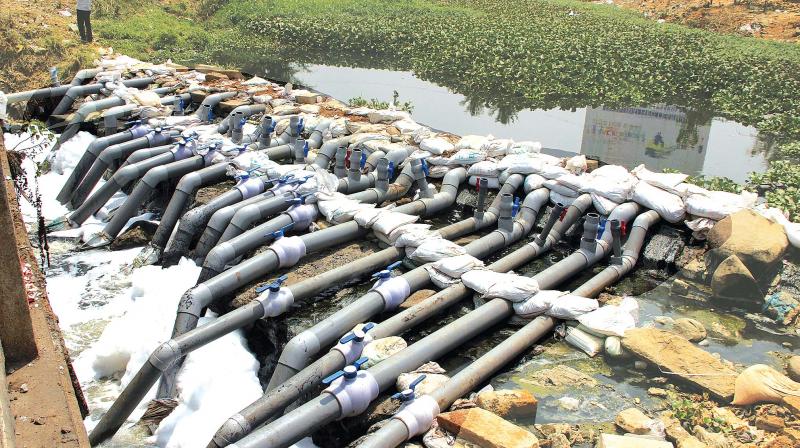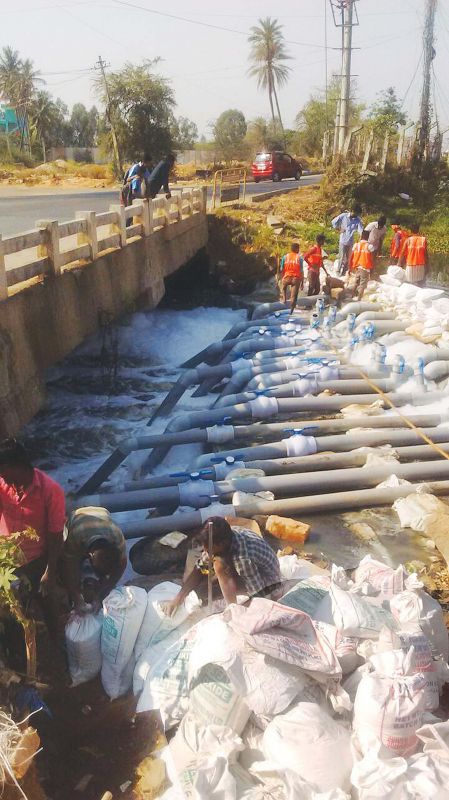New lake tech: That sinking feeling!

The BBMP’s use of siphon technology at Varthur Lake has reduced the froth by nearly 70 percent. However, this is only a temporary measure as pollutants remain untreated in the water body. The plan is to hand over the upkeep of the waterbody to UK and Israeli firms. Experts point out that this will incur a huge cost to the exchequer and instead suggest measures like curbing raw sewage, de-weeding and installing aerators to solve the problem at much lower expense. Aknisree Karthik reports
It’s an experiment that seems to be working. While the government toys with expensive solutions suggested by foreign firms to the frothing at Varthur lake, the BWSSB has quietly begun to tackle it using a simple technology and only in a few days has achieved good results: the frothing is lesser by nearly 70 per cent.
While the people living around the lake are happy with the new siphon technology that reduces the speed of the sewage flowing into the lake by passing it through a series of inverted U-shaped tubes and causes it to froth less, they are only too aware that it is a temporary solution and does not tackle the pollution that is the root cause of it .
Says water expert and member of the People's Campaign for Water, Kshthij Urs, "The siphoning technique only reduces the froth at the lake, but does not make the water less polluted. What the government needs to do is control the entry of industrial effluents and sewage upstream of the lake, which is causing all the pollution and frothing.”
Not sure why the government is not giving the simple solutions suggested by several local scientists to clean up Varthur lake a chance, he regrets that it instead seems hung up on foreign firms and expensive technology to do the job.
"I am not against any foreign firms or technologies. But you must remember, its not private, but public money, which is going into cleaning the lake and it cannot be simply spent like this," he stresses, adding, “I feel there is a deliberate attempt to create a crisis situation by the government so that it can come up with a huge project running into a thousand crore to clean up Varthur and Bellandur. Ideally, it needs to produce a scientific white paper on these lakes and set up a committee with scientists, elected representatives and activists on board to revive them.”
Former senior bureaucrat of the state turned environmentalist, Yellappa Reddy, who is on the high powered committee headed by Chief Secretary, Mahendra Jain to revive the frothing Bellandur and Varthur lakes, is also against handing over the job to UK and Israeli firms.
“Instead of spending thousands of crores this way, the committee is finalising proposals to revive the lakes on a small budget and will submit them to the government in the coming week,” he reveals.
His solution is simple. "We need to take up deweeding of the lakes and follow this up by installing aerators. Once we also encourage their aquatic life, we will solve the problems of Varthur and Bellandur," he adds.
Mosquitoes giving sleepless nights to Varthur residents
The Varthur lake may not be frothing as much as before, but the troubles of the people living around it are not any less. In fact, there is a new menace stalking them. Most are complaining of a sudden surge in mosquitoes in the area, which is leaving them both sleepless and irritable.
Says Mr Shiv Shankar, a member of the civic group, Whitefield Rising, "For the past fortnight or so we have been invaded by mosquitoes. We are not sure what has caused this sudden rise in their population, but the hyacinth on Varthur lake has always been an excellent breeding ground for them. Although it is summer we are forced to keep our doors and windows shut to keep them out.”
The activist suggests that instead of simply spraying the area to deal with the mosquitoes, the authorities should clear the hyacinth on the lake to stop them from breeding.
“The BBMP needs to visit the area and find out why there is this sudden surge in mosquitoes here and tackle the problem on a war footing,” he insists.
Mr Ramesh, a resident of Varthur , says while big apartments have costly devices to deal with the mosquito menace and others use repellants, most of the poor depend on mosquito coils, which don’t seem to work very well.
Lamenting the government’s lack of interest in Varthur and its troubles, he says its high time it woke up and did something about them.
- BWSSB on the basis of the idea of BMRCL chief Mr Pradeep Kharola has adopted siphoning technology to reduce froth at Varthur lake
- While the trail run has yielded result and reduced froth by 70 percent, residents around the lake complain of sudden surge in mosquito population.
- Water experts welcome siphoning technology but opine that it cannot to carried to the large extent of lake spread over 100 acres.
- Opposing foreign firms which has come forward to revive the lake at a cost of hundreds of crores, experts opine that the fundamental principal of curbing the inflow of raw sewage and industrial effluents will help a lot in revival of the lake.
Guest column:Reviving lakes isn’t rocket science, we don’t need foreign firms, says Akshay Heblikar
Reviving the frothing Varthur and Bellandur lakes does not require rocket science and nor do we need any foreign firm, charging thousands of crores, to do the job.
While the siphoning technology will no doubt reduce the froth greatly on Varthur lake, it is only a short term measure and can be used in just a portion of it.
If we want to revive Varthur or Bellandur lakes we need to curb the inflow of raw sewage and industrial effluents into them. We all know this, but one doesn’t know why the government isn’t doing anything about it.
If this is done then most of the lake's problems will vanish. Excessive nutrient supply to the lake in the form of raw sewage and industrial effluents leads to dense growth of plants, including water hyacinth, which is an excellent breeding ground for mosquitoes. The decrease in the froth on Varthur lake could be the reason for the sudden surge in mosquito population in the area.
Once we curb the inflow of raw sewage and effluents into the lake, we will then be left with only with the problems of deweeding and installing aerators, which the government can do with the help of experts.
This will not cost it much, but it is still considering handing over the responsibility of reviving the lake to UK and Israeli firms.
Once deweeding is done and aerators are installed, we will need to encourage the growth of phytoplanktons and zooplanktons as they will help keep the lake clean.
The author is environmentalist and director of Eco Watch



